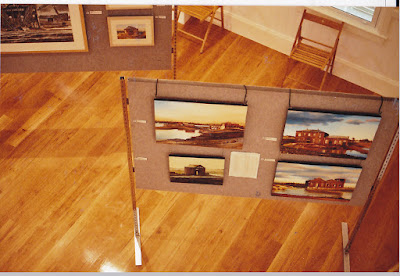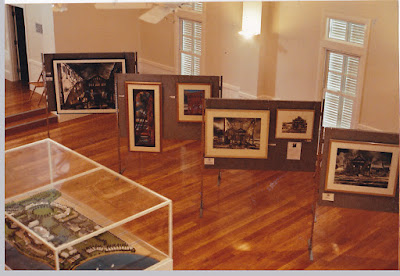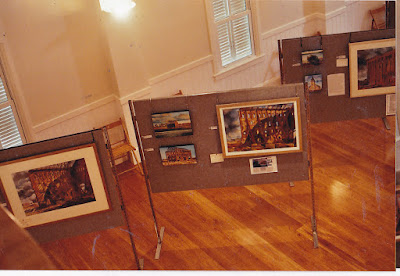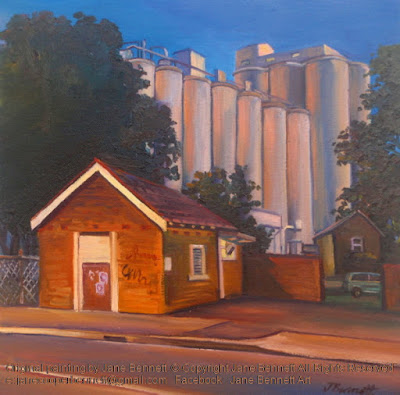 |
| DH143 Preparing for a boat lift 2007 oil on canvas 92 x 122cm Available for sale |
 |
| DH143 Preparing for a boat lift 2007 oil on canvas 92 x 122cm Available for sale |

 |
| DH143 Preparing for a boat lift 2007 oil on canvas 92 x 122cm Available for sale |
 |
| DH143 Preparing for a boat lift 2007 oil on canvas 92 x 122cm Available for sale |
About 50 years ago, the containerization
of shipping modified the wharves dramatically & transformed port cities beyond recognition.
The humble shipping container isn't just a metal box - it created the world as we know it today.
Once goods were loaded and transported around the world as "break bulk" cargo. Container standardization revolutionized global trade, making it easier, quicker and cheaper. However,with the advent of the container, some of the mystery & magic of the shipping industry was lost forever.
wake up
look around
memorise what you see
it may be gone tomorrow
everything changes. Someday
there will be nothing but what is remembered
there may be no-one to remember it.
Keep moving
wherever you stand is ground zero
a moving target is harder to hit
"Ground Zero" by Michael Dransfield
 |
| AGL38 'AGL Site, Mortlake' 2004 oil on canvas 75 x 100 cm Available for sale |
 | |
| Exhibition of AGL site Mortlake paintings in Breakfast Point Community Centre 2004 |


Exhibition of AGL site Mortlake paintings
in Breakfast Point Community Centre 2004
The former
AGL Gasworks site has now been completely redeveloped into the controversial new gated suburb of Breakfast Point by Rosecorp.
The complex of white and pale beige apartments and townhouses is totally
unrecognizable from its industrial past.

Exhibition of AGL site Mortlake paintings
in Breakfast Point Community Centre 2004
To coincide with the opening of their new suburb, Rosecorp and the CFMEU jointly invited me to hold a solo exhibition in their freshly built Community Hall.
My paintings consisted almost entirely of renditions of the C.W.G. Building, which had recently been demolished.
Irony totally intentional.
Related Posts
In 2003, the State Government announced that the stevedoring wharves at East Darling Harbour, on the western edge of Miller's Point, known since the Depression as the 'Hungry Mile', would be transformed into a new urban precinct, which would later be known as Barangaroo.
The wharf has now closed forever and Sydney’s traditional role as a working harbour is essentially over.
For Sydney Harbour no longer to be a working port and to be stripped of its original character and purpose, was almost unthinkable.
I resolved to paint its hidden history before it was too late. This concrete expanse was often derided as 'ugly', usually by people who had never set foot on it, but I found it a rich and fascinating source of inspiration for a series of several hundred paintings.
I became 'Artist in Residence' in 2003, and was still painting there after the last wharfie left in October 2007. I always painted 'en plein air', even though the completed works have the compositional poise of a Jeffrey Smart.
DH135A 'Maintaining the crane' Diptych
2007 oil on canvas 51 x 25.5cm each panel
Available for sale




SU3 Summer Hill Mungo Scott Flour Mills Late Afternoon
2009 oil on canvas 30 x 30cm
Available for sale
It exploited the newly built Metropolitan goods line between Wardell Road and Darling Harbour.
The Summer Hill freight line, alongside Hawthorne Canal, was used twice a week to service the Mills. This branch line was the last operational section of the once mighty Metropolitan goods line before it was redeveloped as light rail/cycling track.
SU2 Summer Hill Mungo Scott Flour Mills Evening
2009 oil on canvas 30 x 30cm
Available for sale
A huge fire in the mill in 1927 was believed to have been caused by sparks caused by passing trains igniting stored flour.
The landmark silos appeared in the early 1950s, as Goodman Fielder grew the Mill’s capacity. Allied Mills took control of the buildings in the 1950s and they were used as a key processing facility for wheat grown in New South Wales until 2009.
The last train ran to the Mungo Scott flour mill on 1 December 2008.

SU1 Summer Hill Mungo Scott Flour Mills by Night
2009 oil on canvas 30 x 30cm
Available for sale
As the Mungo Scott Flour Mills were conveniently close to the Taylor galleries in Smith street where I held regular exhibitions, I was well placed to be able to paint canvases of some of its last operations, including some of the last flour trucks to leave the Mills.
Allied Mills finally vacated the site forever in about 2010 and moved their operations to a huge site in Picton, in Sydney's south-west, which I drive past whenever I exhibit my paintings at the Thirlmere Festival of Steam.
SU6 Summer Hill Mungo Scott Flour Mills Last Flour truck
2009 oil on canvas 41 x 61cm
PRIVATE COLLECTION : SYDNEY
Enquiries about other Summer Hill paintings
The precinct is now redeveloped and is home to offices and more than 400 apartments.
Related Posts
Painting from the silos of the Mungo Scott Flour Mills
The empty mask - Edwin Davey Flour Mills
Today's painting on the easel of my 'deck gallery' is a view of and from the silos of Summer Hill’s famous Mungo Scott flour mill. This vast behemoth was an icon of Sydney’s inner west skyline for nearly 100 years.
It also evokes memories of a gallery where I used to exhibit between 2003 - 10.
From the early 1990s I used to exhibit in the Delmar Gallery in Summer Hill. When the Director, Max Taylor, left to establish his own gallery, the Taylor Galleries, I exhibited there from 2003 until its closure in 2010. The Mungo Scott flour mill was just a few doors down from the Taylor Galleries in Smith Street, Summer Hill. I was utterly fascinated with it and often painted views of it from the surrounding streets before or after delivering or collecting paintings.
SU12 Mungo Scott Flour Mills Night from the top of the silo
2007 oil on canvas 30 x 30cm
Available for sale
One day in 2004 I finally plucked up the courage to ask to be allowed to paint there. They couldn't have been kinder!
I was given the 'grand tour' of the Escher like maze of criss-crossing, zig-zagging walkways from the main building to the top of the silos. When I returned to paint there, everyone helped carry my easel and wet canvases.
Just as well, as while I was certainly strong enough, I would have been hopelessly lost getting from one building to another. It was so confusing navigating the various levels, and it was complicated by the fact that it was still an operational flour mill.
My guide wore a 'Gumby' style hairnet, goggles and gloves. He joked that people knew whether or not they were gluten intolerant within the hour.
Apparently I am - I was sneezing, wheezing & itching, and had to wear a mask whenever I painted there as I had trouble breathing. I've never really liked bread, and now I know why! 
SU8 Summer Hill Mungo Scott Flour Mills Panorama
2004 ink acrylic pastel on paper 118 x 118cm
Available for sale
The silos were truly scary, especially at night. They were very high up, sloped & some didn't even have guardrails. When I was drawing and painting my huge panoramas of the unforgettable view of the inner west from the top of the silos, I was frankly terrified as I had unfortunately picked the highest silo, and for extra points it didn't have a guardrail.
SU7 Summer Hill Mungo Scott Flour Mills Panorama
2004 oil painting on canvas 91 x 122cm
Enquiries about other Summer Hill paintings
The spectacular view made up for the danger. The Summer Hill freight line carving its way through the inner west was directly beneath me.
Soon it would be literally re-cycled. Some of it would be reserved for light rail, and some would be a cycling track.
I was lucky to get to the Mungo Scott Flour Mills in time. Summer Hill was fast being engulfed by the tide of gentrification transforming former gritty industrial zones into hip neighbourhoods, driving up rents and pushing artists even further away from the inner city.
Related Posts




